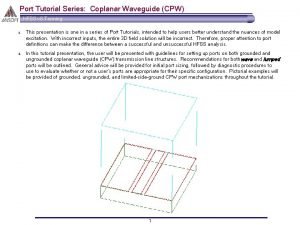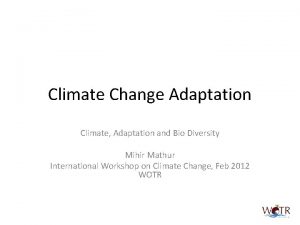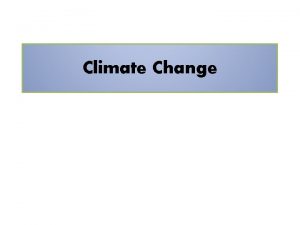Climate change adaptation in port infrastructure Investing in












- Slides: 12

Climate change adaptation in port infrastructure: Investing in climate resilience Craig Davies | Head of Climate Change Adaptation, EBRD COP 22/SLo. Cat side-event: Transport Adaptation to Climate Change in Africa Marrakesh, 9 November 2016

EBRD and climate change adaptation • Many of the EBRD’s countries of operation are vulnerable to climate risks such as water scarcity, altered hydrology and flooding. • Climate vulnerability is worsened by poor infrastructure, suboptimal technologies, poor policy context and lack of data, and limited access to appropriate finance. • The EBRD helps clients undertake actions to adapt to climate change and make them resilient by identifying potential climate risks and providing both technical and financial support. 2

EBRD adaptation finance Climate resilience investment since 2011 (€ in million) 169 147 € 641 million 125 € in billion 138 invested since 2011. 63 107 adaptation 2011 2012 2013 2014 projects signed Oct 2015 By business area (€ in million) 439 South-Eastern Europe 278 Transport 65 98 Agribusiness 40 Central Asia Southern and Eastern Mediterranean Power and Energy 35 Financial institutions 28 Turkey 60 Natural Resources 23 Eastern Europe and Caucasus 44 Central Europe and Baltics 43 Russia 32 Municipal & environmental Infrastructure 4% 5% 6% 10% 68% Property and Tourism 6 Manufacturing and Services 7 Total 24 September 2020 By region (€ in million) 641 Regional Total 82 4 641 3

EBRD in the Port Sector A portfolio of 50 projects and 1 bln EUR invested in 17 countries To deliver Transition… • Bridging the infrastructure gap • Port Sector reform: Restructuring, Corporatization and Commercialization (tariff reform, institutional development, etc. ) • Active support of private sector participation …. And tackle climate change • More focus on port sector: Promotion of maritime/intermodal transport • Identification of EE opportunities for greener ports (TC funds available) • Introduction of green standards and requirements (eg. ISO 50000, carbon footprint) • Mobilization of grants and incentives to overcome barriers • Identification of project risks and support for climate resilience 24 September 2020 design 4

How to deliver Sustainable Ports? • • • Over EUR 18 mln p. a. mobilized to support sector reforms and challenges TCs for project identification (eg. Energy Audits) and preparation (IPPF) Policy Dialogue • Improve business environment and regulatory framework Engagement with MDBs, donors and B 2 B initiatives (eg. PIANC) Technical Cooperat ion • Financing • • 24 September 2020 Tailored financing options Risk mitigation – catalyst (IFI status) Mobilize climate funds 5

EBRD investments in sustainable ports Klaipeda Smelte (32 m€) Transhipment container terminal: Identification of EE opportunities & carbon footprint DCT Gdansk (45 m€) Assessment CCA and incorporation of Green Technologies (cold ironing) Danube Logistics (20 m€) New multi-purpose/ intermodal terminal 24 September 2020 Nador West Med (200 m€) Review of opportunities for Sustainability and CCA Globalports (80 m€) Financing EE programme across four terminals Port Odessa (various) Export Capacity for Grain with greener technologies 6

EBRD guidance on climate resilience in port investments Internal technical guidance developed by EBRD in 2013 • A ‘first step’ intended to pilot approaches and build experience • Subsequently applied on a number of port sector investments 7

Port Expansion: Poland Key climate risks: • Changes in sea ice (positive) • Sea level rise • Changes in rainfall intensity • Changes in wave conditions Adaptation measures adopted: • Quayside structures designed to cope with sea level rise of approximately 6 -10 mm per year over the next 100 years • Communication channel established with the Port Authority to receive relevant information about sea level extremes and wave overtopping of port structures 8

New Port Facility: Morocco Key climate risks: • Sea level rise • Increased storminess • Increased extreme heat events Adaptation measures adopted: • Analyse breakwater design taking into account expected sea-level rise over the design life of the Port • installation of surfacing, mechanical and electrical equipment designed to withstand • projected temperature extremes (>40 degrees C) • Installation of surface drainage design able to cope with extreme rainfall and overtopping events • Installation of storage facilities able to withstand extreme temperatures and extreme weather events • Adoption of Emergency Response Plan and Coastal Erosion Monitoring Scheme 9

Scaling up action on climate resilient ports in Morocco ‘la houle exceptionelle’ of January 2014 has raised awareness of climate risks to port infrastructure in Morocco Emerging partnerships to rise to this challenge: • • • PIANC Working Group 178 on Climate Change Adaptation for Ports and Navigation Infrastructure Moroccan port authorities will be supported to benefit from emerging PIANC guidance GEF Special Climate Change Fund has awarded USD 6 million grant resources to co-finance innovative investment in port sector climate resilient upgrades in Morocco

Guidance and standards are needed to scale up adaptation action

Contacts For all further enquiries, please contact: Craig Davies Associate Director Head of Climate Change Adaptation Energy Efficiency and Climate Change Team email: daviesc@ebrd. com EBRD One Exchange Square London EC 2 A 2 JN, United Kingdom 24 September 2020 12
 Climate change 2014 mitigation of climate change
Climate change 2014 mitigation of climate change Direct investing vs indirect investing
Direct investing vs indirect investing 8255 ppi architecture
8255 ppi architecture 8255 block diagram
8255 block diagram Lump port wave port
Lump port wave port Network infrastructure management
Network infrastructure management Climate change paragraph
Climate change paragraph Karnataka state action plan on climate change
Karnataka state action plan on climate change How many major climate types are there worldwide brainpop
How many major climate types are there worldwide brainpop Climate change meaning and definition
Climate change meaning and definition Atmosphere
Atmosphere Unit 9 climate change
Unit 9 climate change Conclusion of climate change
Conclusion of climate change























